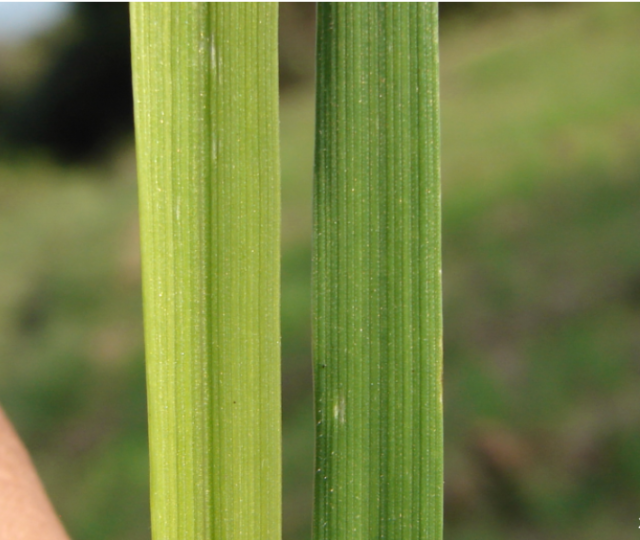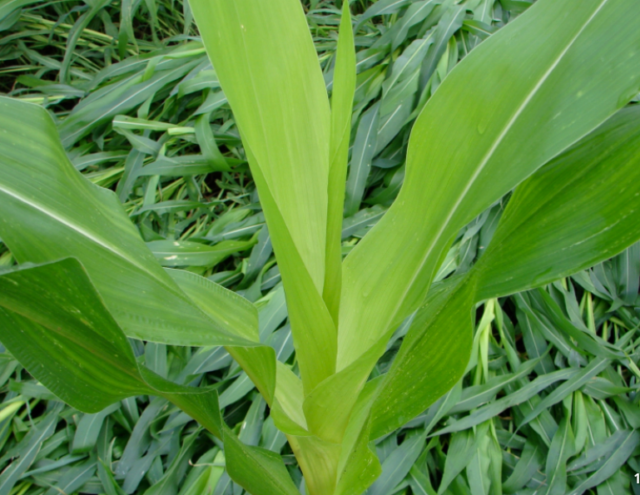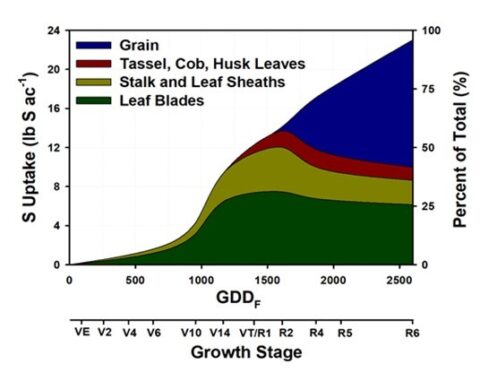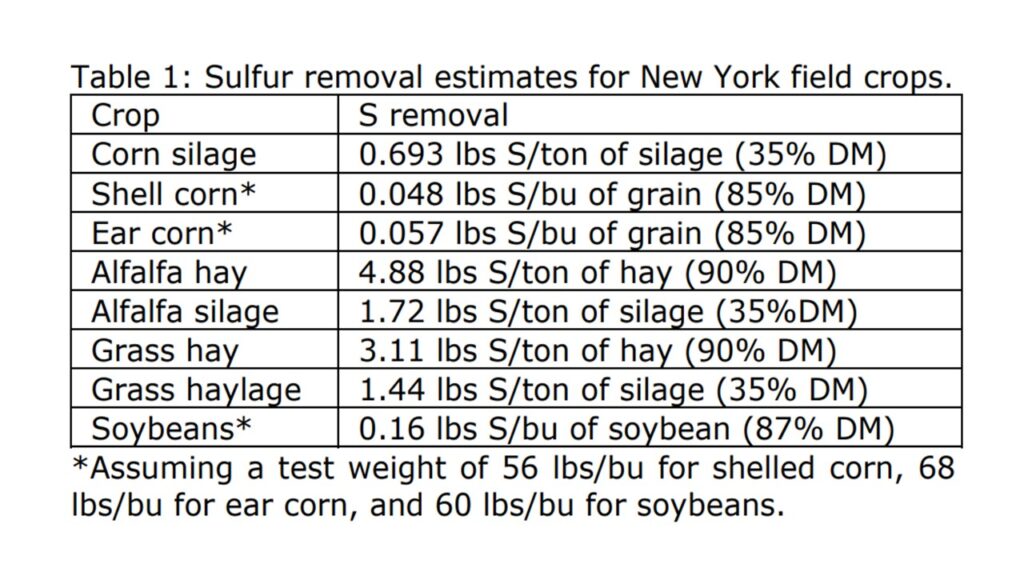
THIS ARTICLE IS SPONSORED BY THE MOSAIC COMPANY
This spring across Eastern Canada we have seen Sulphur (S) deficiencies from the beginning of the season in winter wheat (see figure 1) to emerged corn (see figure 2) in the early part of the growing season. This article will address some of the reasons why we saw wide spread S deficiencies, and the importance of season-long S availability. These topics will be addressed in three main points that are critical in developing a Sulphur fertility plan to provide balanced crop nutrition:
- Crop Nutritional Demand for Sulphur
- Forms of Sulphur & Availability
- Application of Sulphur at the Right Rate, Right Time and the Right Source

ABOVE: Figure 1
Source: Sulfur Deficiency Symptoms

ABOVE: Figure 2
Source: Sulfur Deficiency Symptoms
Crop Nutritional Demand for Sulphur
Sulphur continues to be a hot topic in Eastern Canadian agriculture as yields and crop demand continue to increase. Often misrepresented as a micronutrient, S is actually a macronutrient and is 4th in importance following N, P, and K. As seen in Figure 3, S is necessary throughout all stages of growth and development of a corn crop, but demand increases dramatically after V10. Providing plant available sulphur during reproductive stages of growth is especially critical to maximize yield.

ABOVE: Figure 3
Source: Bender et al., 2015. Better Crops/Vol. 97 (2013, No. 1, page 9)
What has changed in the past 10 to 20 years to induce more S?
Two factors come to mind: A cleaner environment and higher crop yields. A reduction in industrial and vehicle emissions containing S has reduced the atmospheric deposition of S in farm fields. This; coupled with increasing crop yields (increased S nutrient demand), has led to many soils with depleted sulphur and/or an inability to provide this nutrient at a rate necessary to maximize productivity. It is important to recognize that sulphate-sulphur is mobile in the soil and is often leached to depths beyond the rooting zone of crops. To demonstrate the amount of sulphur removed by crops with each bushel or ton of production, see Table 1 below.

ABOVE: Table 1
Source: Cornell University, “Agronomy Fact Sheet Series #34”, Sulfur for Field Crops, Accessed 6 June 2020, http://nmsp.cals.cornell.edu/publications/factsheets/factsheet34.pdf
Forms of Sulphur and Availability
There are two forms of sulphur: Elemental Sulphur (ES) and Sulphate Sulphur (SO4-2). Sulphate sulphur is the source that is readily available for plant uptake. Unfortunately, the negative charge associated with soil and the negative charge associated with SO4-2 leads to a high leaching potential. Elemental Sulphur, unlike SO4-2, is not plant available and must go through an oxidization process to become plant available (see chemical equation below).

How does all this information contribute to answering the question of why S deficiency was so evident in 2020? Many fields in Eastern Canada either received no sulphur fertilizer applications prior to planting or had applications that were inadequate or leached prior to uptake. Additionally, any applications of ES would have had minimal conversion to sulphate-sulphur since cold temperatures in the spring would have greatly limited microbial activity (critical to ES conversion to SO4-2).
This is why higher rates of Sulphate-containing fertilizers like Ammonium Sulphate and Ammonium ThioSulphate showed dramatic crop responses vs. untreated acres.
Fun Sulphur Fact: For each 1% Organic Matter there contains 100 lb/ac of Organic S in the upper 6-8” of Soil (3)
Think 4Rs when applying Sulphur: Right Source, Right Rate, Right Time and the Right Place
We continue to learn more about S fertility every year as crop demands continues to increase. Figure 3 illustrates not only the amount of S needed throughout the season, but also the growth stage when it is needed. Two key observations worth mentioning:
- Only 50-55% of the total S needed has been taken up by VT.
- S has limited mobility within the plant, meaning that it does not move from the stalk, leaf sheaths, and leaves into the grain.
Knowing this we can put together some 4R management practices:
Right Source:
- There are several sources of Sulphate sulphur and Elemental Sulphur that can be used in cropping systems.
- To ensure season long availability, do not rely on just one source. One has the potential to leach and the other takes time to be become plant available.
- MicroEssentials SZ® (12-40-0-10S-1Zn) provides two forms of sulphur in each and every granule to ensure S is available at both early and late stages of growth.
- K-Mag® (0-0-21.5-10.5Mg-21S) has a unique formulation that provides Sulphate sulphur while also supplying potassium and magnesium.
Right Rate:
- Based on the information provided in Table 1, consider S removal of previous crops, calculate S crop removal based on yield goals of your current crop and build a recommendation to address the season-long need for sulphur.
Right Time:
- Timing of fertilizer applications is critical and understanding the dissolution and crop availability of each fertilizer source selected can offer some flexibility.
- For winter cereals: If we endure a cooler than average spring, ensure enough sulphate sulphur is applied early in the spring. If you have the ability to apply dry starter at planting, consider an application of 100-125 lb/ac of MicroEssentials SZ® which will provide you with 10-12.5 lb of S with ½ being SO4-2 and the other ½ Elemental S and feeding the crop throughout the season.
- Try split applying sulphur to allow for season long availability. Crops like alfalfa have shown excellent responses to products like K-Mag® (0-0-21.5-10.5Mg-21S) when applied after 1st and 3rd
Right Place:
- If application equipment allows, consider fertilizer placement that matches crop root architecture and time of peak needs.
References
- Cornell University, 2007, “Agronomy Fact Sheet Series #34”, Sulfur for Field Crops, Accessed 6 June 2020, http://nmsp.cals.cornell.edu/publications/factsheets/factsheet34.pdf
- The Mosaic Company, “Maximizing Yields and Sulfur Availability”, Accessed 6 June 2020, https://www.cropnutrition.com/resource-library/maximize-yields-and-sulfur-availability
- Purdue University Department of Agronomy , 2017,“Soil Fertility Update – Sulfur Deficiency”, Accessed 6 June 2020, https://www.agry.purdue.edu/ext/corn/news/timeless/SulfurDeficiency.pdf